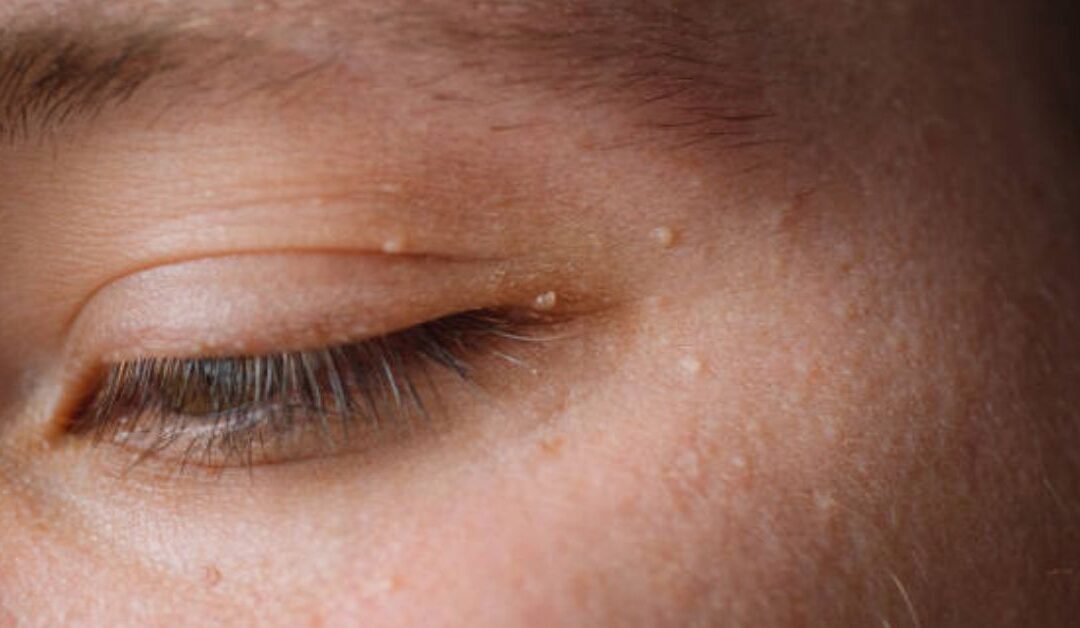Milia are small, hardened cysts that form when keratin becomes trapped beneath the surface of the skin. They typically appear as 1-2 mm white or yellowish bumps. While annoying, milia are harmless and painless. However, some people seek removal for cosmetic reasons. Milia most often occur around the eyes, cheeks, nose, and forehead, but can appear anywhere on the body. Under eye milia removal is one cure that is successful.
There are a few different classifications of milia:
- Primary milia: Formed at birth or during infancy. They occur as the skin develops and are common in newborns.
- Secondary milia: Develop later in life, often as a side effect of damage, inflammation, or sun exposure.
- Milia en plaque: Characterized by grouped clusters of milia, sometimes covering large areas.
What Causes Milia?
Milia form when keratin, a protein found in skin, becomes trapped in small pockets at the base of hair follicles or sweat glands. Possible causes include:
- Genetics – primary milia are hereditary.
- Blistering skin disorders like eczema or bullous pemphigoid. The healing process can cause milia.
- Minor skin trauma from insect bites, burns, or other wounds.
- Blocked sweat ducts or hair follicles.
- Long-term use of heavy creams and oils that block pores.
- Intense pulsed light (IPL) and laser treatments.
- Sun damage, which alters keratin production.
- Skin issues like acne lesions that alter keratin expression.
Treating Milia at Home
Before resorting to medical procedures, it’s worth trying simple at-home treatments:
- Cleanse and Exfoliate – Use a gentle face scrub 2-3 times per week to remove dead skin cells. This helps unclog pores and exfoliate the skin’s outer layer.
- Hydrate – Drink plenty of water and use oil-free moisturizers. Well-hydrated skin has a better ability to shed dead cells.
- Avoid Harsh Products – Steer clear of abrasive scrubs, astringents, toners, and masks that strip the skin. This avoids irritation that can cause milia.
- Sun Protection – Always wear SPF 30 or higher before sun exposure. Sun damage is a common cause of milia formation.
- Warm Compress – Apply a warm, damp washcloth to the affected area for 10 minutes. This helps soften the skin and draw trapped keratin to the surface.
- DIY Extraction – Sterilize a small needle with rubbing alcohol and gently nick the surface of the milium. Use slight pressure to squeeze the keratin out. Only attempt if milia are on the surface.
When to See a Dermatologist for Under Eye Milia Removal
Most primary milia on infants and children resolve spontaneously within a few weeks. However, if home treatments aren’t working after a month or two, see a board-certified dermatologist. A doctor can determine the cause and recommend professional under eye milia removal if necessary.
Medical procedures may be required in these cases:
- Numerous milia clustered together.
- Milia covering a large facial area.
- Milia that persist despite good skin hygiene.
- Milia that cause distress or discomfort.
- Milia that develop after trauma or skin damage.
- Milia that appear red, swollen or inflamed.
Under Eye Milia Removal Methods
Dermatologists have access to safe, effective milia removal techniques. Common medical procedures include:
- Curettage – After numbing the skin, the doctor will use a small spoon-shaped curette tool to scrape off the surface and lift out trapped keratin. The area heals quickly with minimal scarring.
- Lancing/Extraction – A sterile needle is used to puncture the milium and extract the contents. This is a precise method with low risk of scarring.
- Electrodesiccation – A small electrical current applied to the milium dries it out. The cyst then sheds from the skin over 7-10 days.
- Laser Lysis – An ablative erbium or CO2 laser essentially vaporizes the top layer of skin and the milium with it. This requires local anesthesia.
- Cryotherapy – Liquid nitrogen is used to freeze and destroy the milium. The dead tissue later sheds off. Swelling and blistering can occur.
- Microincision Extraction – The newest method, which involves a tiny incision made with a fine blade or needle. This allows the contents to be expressed with low risk of scarring.
Dermatologists choose the method based on factors like the number of milia present, depth, and location.
Recovery and Aftercare
Most under eye milia removal methods have minimal downtime. Mild redness, oozing, and flaking may occur for 1-2 days. Use an antibiotic ointment and avoid makeup, sun exposure, and irritants while healing.
To prevent new milia from developing:
- Use oil-free skincare products labeled “noncomedogenic.”
- Avoid thick creams, mineral makeup, and coconut oil which can clog pores.
- Apply SPF 30 sunscreen daily.
- Exfoliate regularly with a chemical exfoliant containing glycolic, lactic, or salicylic acids.
- Shave carefully to prevent follicular trauma.
- Moisturize with lightweight lotions and serums.
- If using retinoids, use only low concentrations and limit to 2-3 nights per week.
When to Seek Follow-up Care
Schedule a follow-up appointment if:
- Milia recurs frequently in the same area.
- Signs of infection develop, like pus, increased pain, and redness.
- New milia continue to appear.
- Scarring or discoloration remain after 2-3 weeks.
- Your skin is prone to keloid scarring.
Ongoing removal may be needed for recurring milia. But most patients see permanent clearance after 1-2 professional treatments. Proper home care helps prevent new milia from forming.
Know Your Options
While frustrating, milia are benign and more of an aesthetic concern rather than medical issue. Still, they can be annoying. Fortunately, a range of effective under eye milia removal options exist. Work with a dermatologist to determine the best treatment approach based on your skin and type of milia present. Professional extraction helps manage troublesome milia that do not resolve on their own. With close follow up care, most people achieve smooth, clear skin over time.


Recent Comments